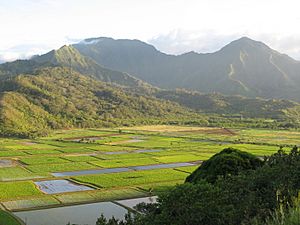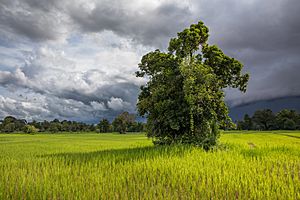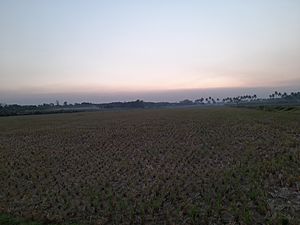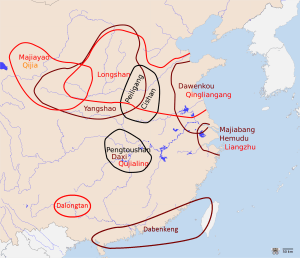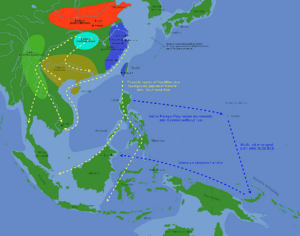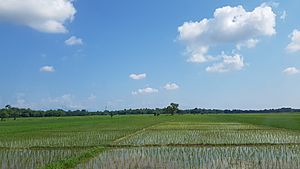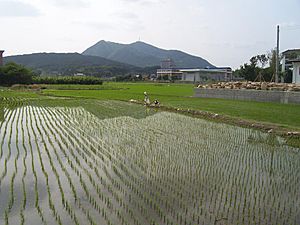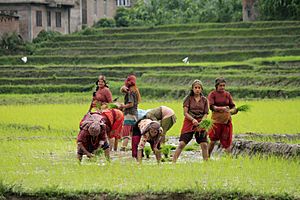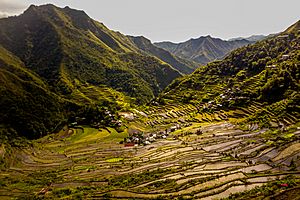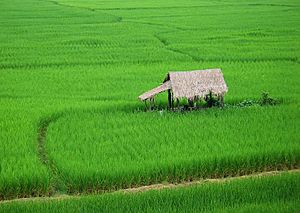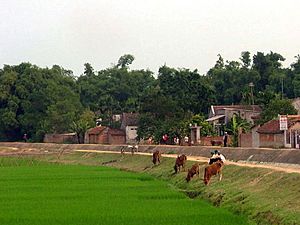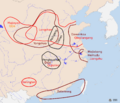Paddy field facts for kids
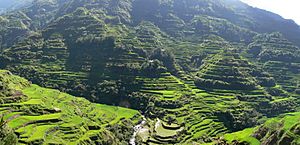

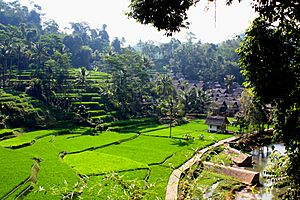
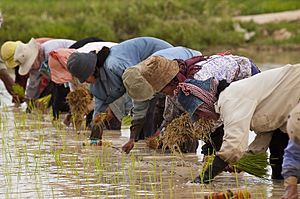
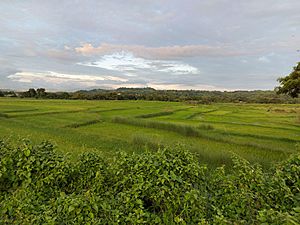
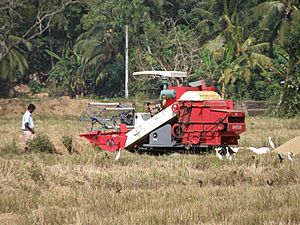
A paddy field is a special kind of field that is flooded with water. It is used to grow water-loving plants, especially rice and taro. This way of farming started a very long time ago in southern China, near the Yangtze River.
This farming method spread across Asia and to places like Madagascar and the islands of Melanesia, Micronesia, and Polynesia. Other cultures in Asia also learned how to grow rice this way.
Paddy fields can be built on flat land or carved into steep hillsides, creating terraces. They need a lot of hard work and water to keep them going. Animals like oxen and water buffalo are often used to help with the farming because they are good at working in wet areas.
Today, paddy fields are still the main way rice is grown. They are found in many countries, including China, India, Indonesia, Japan, the Philippines, and Vietnam. This method has also spread to parts of Europe and the Americas.
Growing rice in paddy fields is different from growing "deepwater rice." Deepwater rice grows in water that is much deeper, usually more than 50 centimeters (20 inches) deep for at least a month.
What Does "Paddy" Mean?
The word "paddy" comes from the Malay word padi. This word means "rice plant." It comes from an even older language called Proto-Austronesian. Many similar words for rice are found in other languages, like paláy in Tagalog.
History of Paddy Fields
How Rice Farming Started in China
Scientists believe that all types of rice we eat today came from a wild rice plant called Oryza rufipogon. This plant was first grown by people in southern China, south of the Yangtze River. This happened between 13,500 and 8,200 years ago.

Rice farming and the idea of wet paddy fields likely started in two main areas along the Yangtze River. People in these areas traded with each other, which helped rice farming spread across southern China.
The oldest known paddy field was found in China and dates back to 4330 BC. This was discovered by looking at rice grains and soil from the past. By 3500 to 2500 BC, many more people lived in these rice-growing areas. They grew a lot of rice in paddy fields and had advanced tools and ways of life.
Later, around 2500 to 2000 BC, there was more conflict in China. This led to rice farming cultures moving south. This is also when groups like the Austronesian people started moving to Mainland Southeast Asia and Island Southeast Asia.
How Rice Spread with Austronesian People
Rice farming in paddy fields came to Southeast Asia with the Austronesian people. They moved from China to Taiwan between 3500 and 2000 BC. In Taiwan, old sites show that people were growing rice in wet fields a long time ago.
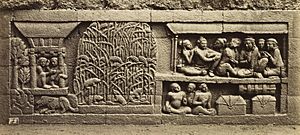
Around 2000 to 1500 BC, Austronesian people started moving from Taiwan to the Philippines. They brought their rice farming skills with them. From the Philippines, they quickly spread across Maritime Southeast Asia, reaching places like Borneo, Sumatra, Sulawesi, and Java. By 500 BC, growing rice in wet fields was common in Java and Bali.
When Austronesian people traveled to Micronesia and Polynesia, rice did not grow well there. However, they used their wet-field farming skills to grow other crops, especially taro. They also shared these farming methods with people in New Guinea.
Rice and wet-field farming also reached Madagascar and the coast of East Africa around 1000 AD.
Paddy Fields in Korea
Korea has ten old rice paddy fields that archaeologists have found. The oldest ones are in Ulsan and date back to the early Mumun pottery period.
Paddy field farming has been done in Korea for thousands of years. Early rice cultivation might have started around 3500–2000 BC. Old paddy fields have been found near Miryang and Ulsan.
The earliest paddy fields were often in low, wet areas near streams. Some flat paddy fields were made of squares and rectangles separated by small walls called bunds. Terraced paddy fields followed the natural shape of the land on hillsides.
Farmers in the Mumun Period (around 1100–850 BC) used many of the same things we see in paddy fields today. These include terraces, bunds, canals, and small water storage areas. Wooden tools from this time have been found. Iron tools for farming were introduced later, after 200 BC. When iron tools became common, paddy fields became much larger.
Paddy Fields in Japan
The first paddy fields in Japan appeared during the Early Yayoi period (300 BC – 250 AD). It seems that wet-field farming developed in Japan after it did in the Korean peninsula.
Rice Farming Around the World
| China | 204.3 |
| India | 152.6 |
| Indonesia | 69.0 |
| Vietnam | 43.7 |
| Thailand | 37.8 |
| Bangladesh | 33.9 |
| Myanmar | 33.0 |
| Philippines | 18.0 |
| Brazil | 11.5 |
| Japan | 10.7 |
| Pakistan | 9.4 |
| Cambodia | 9.3 |
| United States | 9.0 |
| Korea | 6.4 |
| Egypt | 5.9 |
| Nepal | 5.1 |
| Nigeria | 4.8 |
| Madagascar | 4.0 |
| Sri Lanka | 3.8 |
| Laos | 3.5 |
| Source: Food and Agriculture Organization | |
China
China grows the most crops in the world, and rice is its most important one. About 25% of China's farmed land is used for rice. Most rice is grown in the southern parts of China.
Evidence suggests that rice was used by people in China as early as 11,500 years ago. It is thought that the Yangtze River area was where rice farming first began.

Around 722–481 BC, farming in China got much better. Farmers started using iron tools and animals to pull plows. They also began to control rivers and build water conservation projects to help with irrigation. These improvements helped rice farming grow across China.
By 1250 AD, most of China's population lived in the south. This was partly because new types of rice from Vietnam ripened quickly, allowing farmers to grow rice more than once a year.
Famous rice paddies in China include the Longsheng Rice Terraces and the fields of Yuanyang County, Yunnan.
India
India produces the most rice in the world and is also the biggest exporter of rice. Paddy fields are very common across India. Rice is grown at least twice a year in most parts of India. One season depends on irrigation, and the other depends on the Monsoon rains.
Rice farming is a big part of life in rural India. Many festivals celebrate the rice harvest, like Onam and Thai Pongal. Some regions are known as the "rice bowls" of their states, like Thanjavur in Tamil Nadu and Kuttanadu in Kerala.
Indonesia
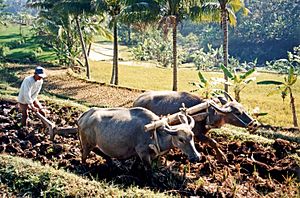
Rice production in Indonesia The rich volcanic soil in Indonesia, especially on the islands of Java and Bali, makes rice a very important food. Farmers often plant rice three times a year if they have enough water.
Planting rice is hard work. Farmers first plant seeds in a small area. After about three weeks, they carefully pick the young rice plants and replant them further apart in the flooded fields.
On Bali, the steep land led to complex irrigation systems called subak. These systems help manage water for the rice terraces.
Italy
Rice is grown in Northern Italy, especially in the valley of the Po River. The paddy fields get water from fast-flowing streams coming down from the Alps. In the past, many poor women called mondine worked in these rice fields during certain seasons.
Japan
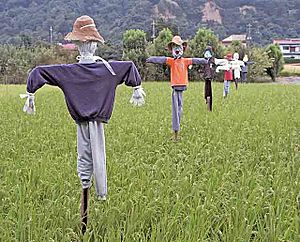
Japan's soil is often acidic due to volcanoes, which makes paddy fields a very good way to farm there. The Japanese word for paddy field is 田 (read as ta or den). This word has had a big impact on Japanese culture. It is used in many place names and family names.
For example, Tanaka (田中) means "in the paddy field." Nakata (中田) means "middle paddy field." Many people chose names related to paddy fields during the Meiji Period when everyone had to have a family name.
Today, people in Japan eat less rice, and many rice farmers are getting older. The government helps rice farmers and limits cheaper imported rice.
Korea
In South Korea, paddy fields are found in the small, flat river valleys. Farmers usually check and repair their fields in February and March. In May, they plant young rice plants into the flooded fields. Farmers take care of the fields all summer. The harvest begins in October.
Many Korean farmers have small paddy fields in different places. Modern harvesting machines are sometimes shared among family members. Farmers usually dry the rice grains in the sun before selling them.
The Korean word for 'paddy' is "non" (Hangul: 논).
Madagascar
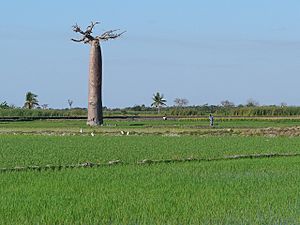
People in Madagascar eat a lot of rice, about 130 kilograms (287 pounds) per person each year. Most of the rice grown there uses irrigation systems.
One traditional way of growing rice is called "tavy." This involves burning parts of the natural rainforest to clear land for rice. While it helps farmers, it also causes deforestation. Another method, "tanety," grows rice on grassy slopes that were cleared for making charcoal.
Madagascar has many types of rice, including "Vary lava" (a long-grain rice) and "Vary mena" (red rice), which is only found in Madagascar.
Malaysia
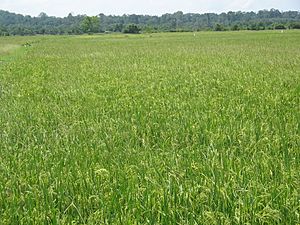
Paddy fields are common in most states on the Malaysian Peninsula. Many are in the northern states like Kedah and Perlis. They are also found on Malaysia's east coast and in the central state of Selangor.
In the past, many people in Malaysia worked in agriculture, especially growing rice. So, houses were often built near paddy fields. The very spicy bird's eye chili is called cili padi in Malaysia, which means "paddy chili."
Myanmar
Rice is grown in Myanmar mainly in three areas: the Irrawaddy Delta, the area around the Kaladan River, and the central plains near Mandalay. In recent years, more rice farming has started in Shan State and Kachin State. Myanmar used to be a major rice exporter.
Rice is now grown in all three seasons in Myanmar, but mostly during the Monsoon season (June to October). Rice in the delta areas uses river water and minerals from the mountains. Rice in central regions needs irrigation from the Irrawaddy River.
Fields are tilled when the first rains come, usually in early June. Today, tractors are used, but in the past, water buffalos did the work. Rice plants are grown in nurseries and then moved by hand to the prepared fields. The rice is harvested in late November. Most of the planting and harvesting is done by hand.
Nepal
In Nepal, rice (Nepali: धान, Dhaan) is grown in the Terai plains and hilly regions. It is mainly grown during the summer monsoon.
Philippines
Paddy fields are a common sight in the Philippines. Large paddy fields are found in provinces like Ifugao, Nueva Ecija, and Isabela. Nueva Ecija is known as the main rice-growing province in the Philippines.
The Banaue Rice Terraces are a famous example of paddy fields in the country. They are in Banaue in Northern Luzon and were built by the Ifugaos about 2,000 years ago. Streams and springs from the mountains are used to water these terraces through irrigation canals. Other notable Philippine paddy fields include the Batad Rice Terraces, which look like an amphitheatre.
Sri Lanka
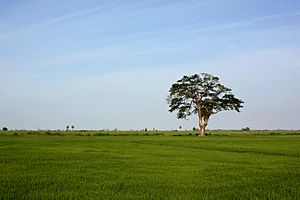
Sri Lankan paddy cultivation has a history of over 2000 years. Sri Lanka was once called the "paddy store of the east" because it produced so much rice. Paddy fields are found all over the island. Most are in the dry zone and use special irrigation systems with water tanks called "Wewa."
Agriculture in Sri Lanka mainly depends on rice production. Sri Lanka sometimes exports rice to nearby countries. About 1.5 million hectares of land are used for paddy farming. Around 879,000 farmer families work in paddy cultivation, making up a big part of the country's population and jobs.
Thailand
Rice production in Thailand is a very important part of the Thai economy. More than half of Thailand's farmland and workers are involved in growing rice.
Thailand has a long history of producing rice. It has the fifth-largest amount of land used for rice farming in the world and is the world's largest exporter of rice. The most common type of rice grown in Thailand is jasmine rice. This rice does not produce as much per field as other types, but it sells for a much higher price around the world.
Vietnam
Rice fields in Vietnam (called ruộng or cánh đồng) are the main type of land use in the Red River valley and the Mekong Delta. In the Red River Delta, a large network of dykes (walls) helps control seasonal river flooding. In the Mekong Delta, there are many canals for drainage and irrigation. These canals also serve as transportation routes for farmers to take their crops to market.
A main festival related to rice farming is "lễ hạ điền" (meaning "descent into the fields"). It is held at the start of the planting season to hope for a good harvest. In the past, this event was very grand, with the monarch performing the first plowing.
In Vietnamese, being wealthy is often linked to owning large amounts of land. A common saying for very large paddy fields is "storks fly with their wings out-stretched" ("đồng lúa thẳng cánh cò bay"). The sight of wind-blown rice plants in a paddy field is beautifully called "waves of rice plants" ("sóng lúa").
Ecology of Paddy Fields
Paddy fields release a gas called atmospheric methane into the air. This gas is a type of greenhouse gas. It is estimated that paddy fields contribute a lot of methane each year.
Studies have shown that farmers can reduce methane by draining the fields sometimes. This allows the soil to get air, which stops methane from being made. This can also help the rice grow better.
Images for kids
-
A model of an ancient city from the Liangzhu culture (3400 to 2250 BC). It is surrounded by a moat and rice paddies.
-
A carving from the 9th-century Borobudur temple in Indonesia. It shows a rice barn and rice plants with mice. Rice farming has a long history in Indonesia.
See also
 In Spanish: Arrozal para niños
In Spanish: Arrozal para niños


